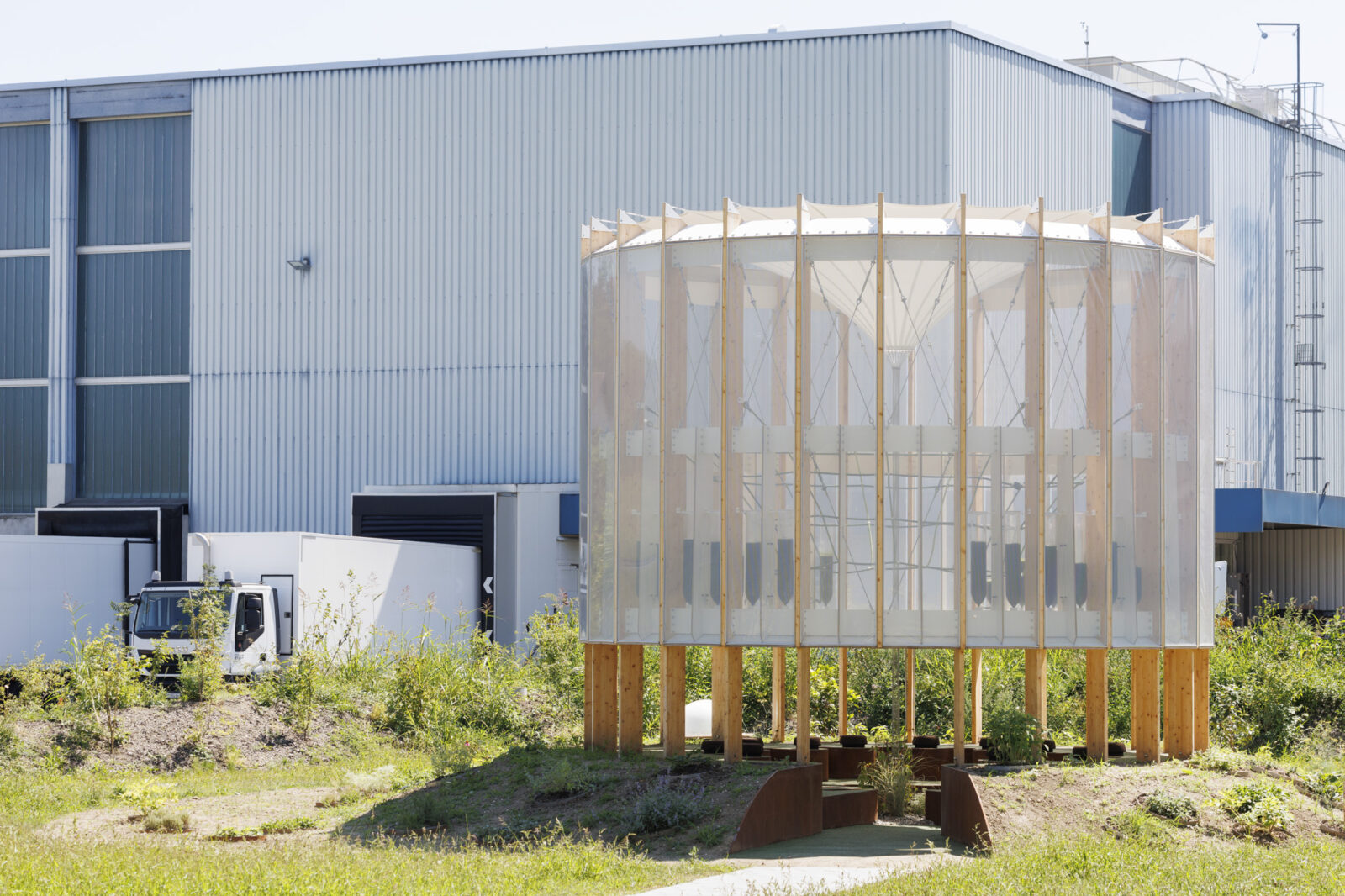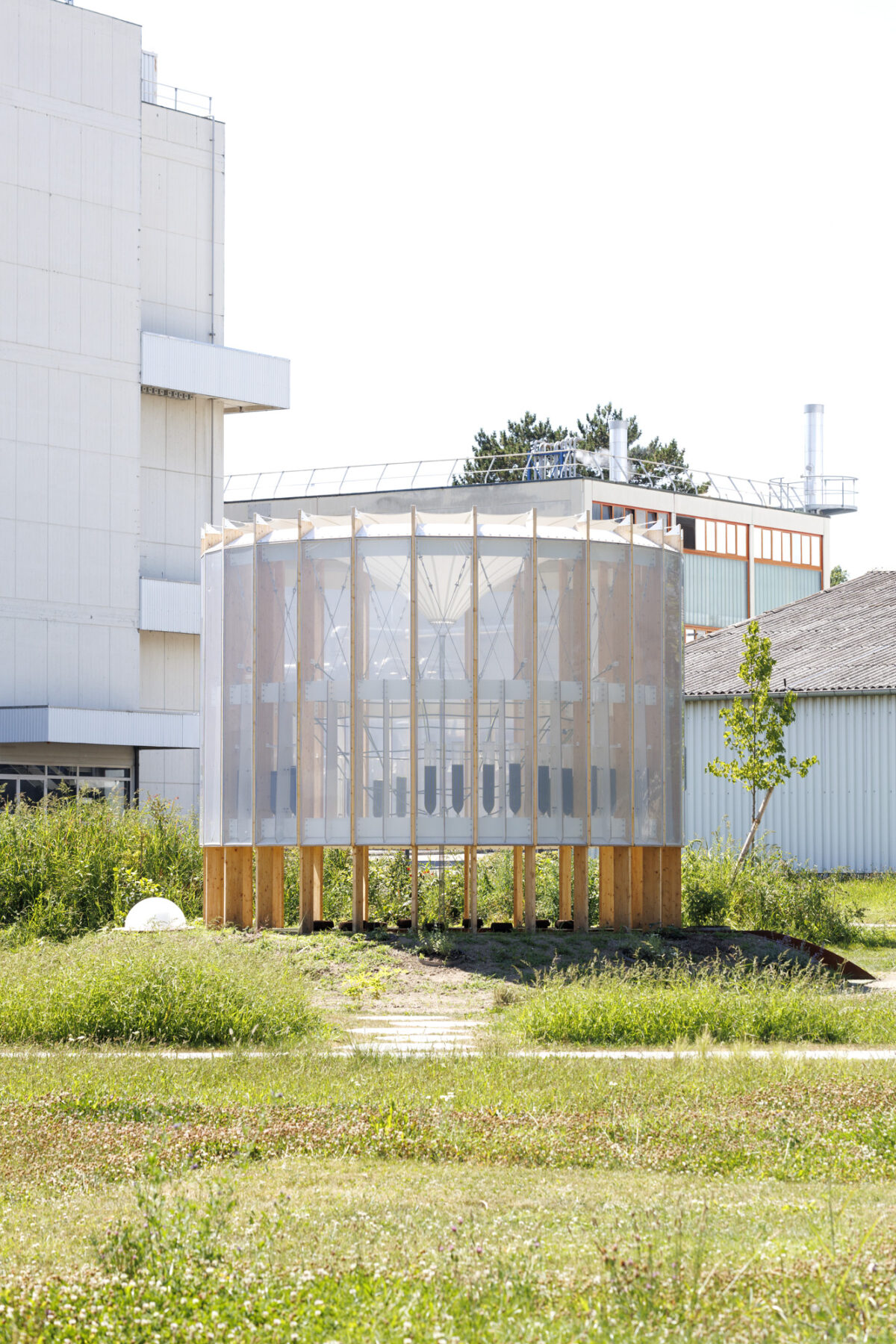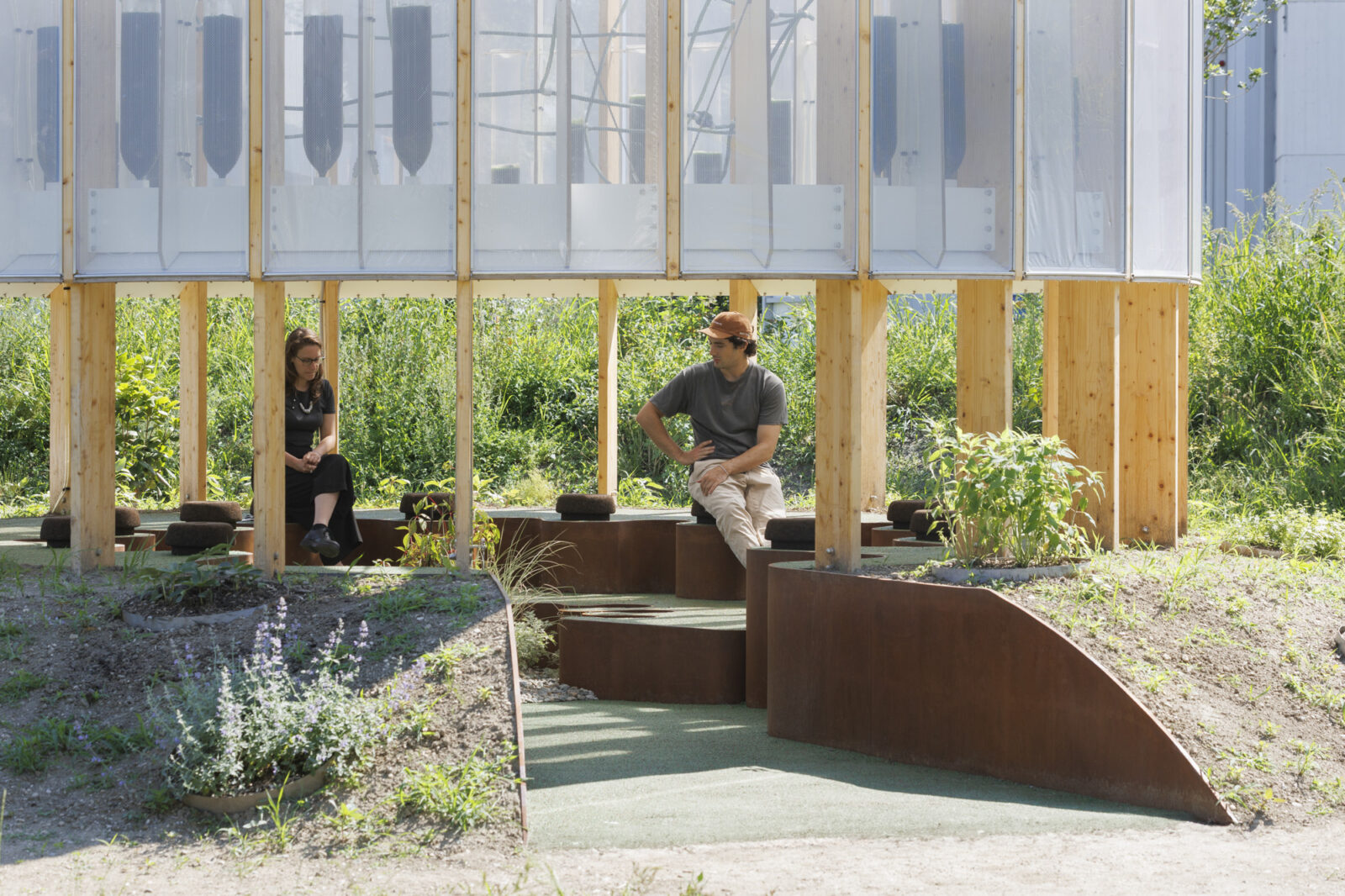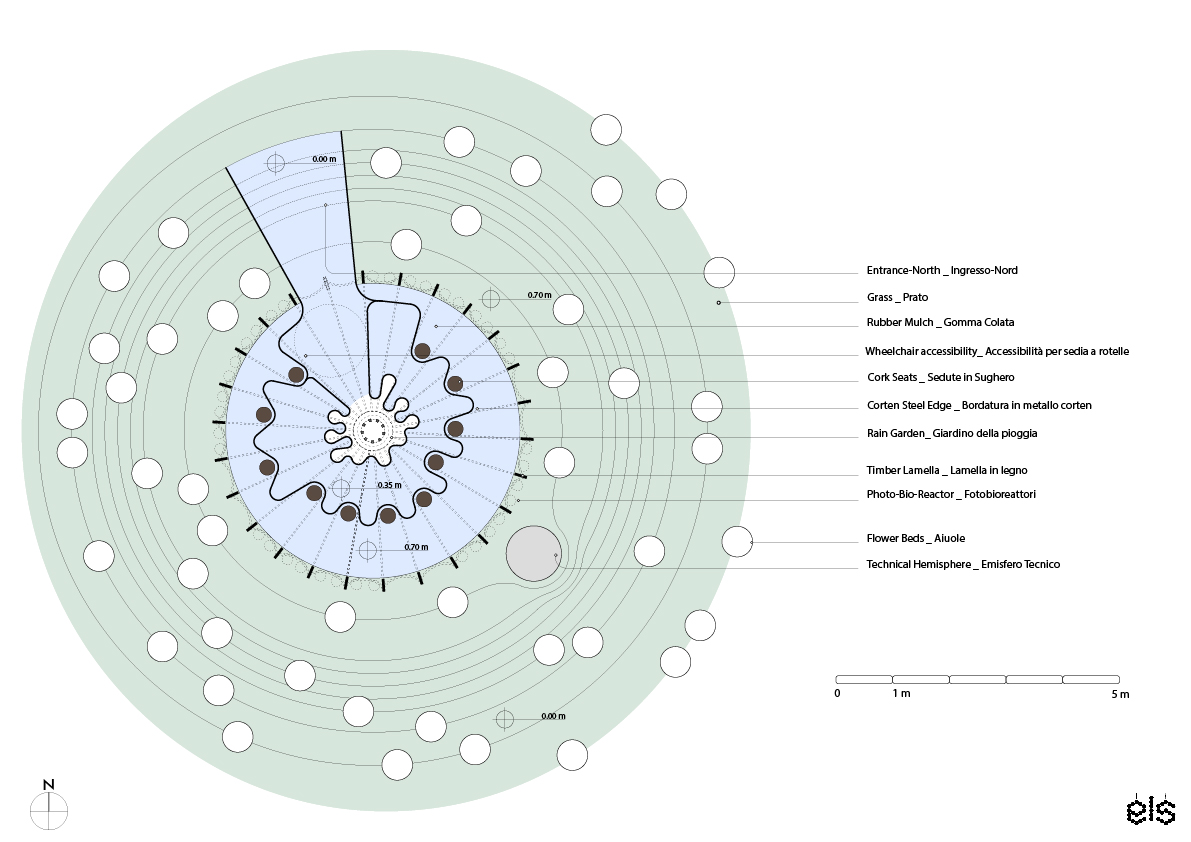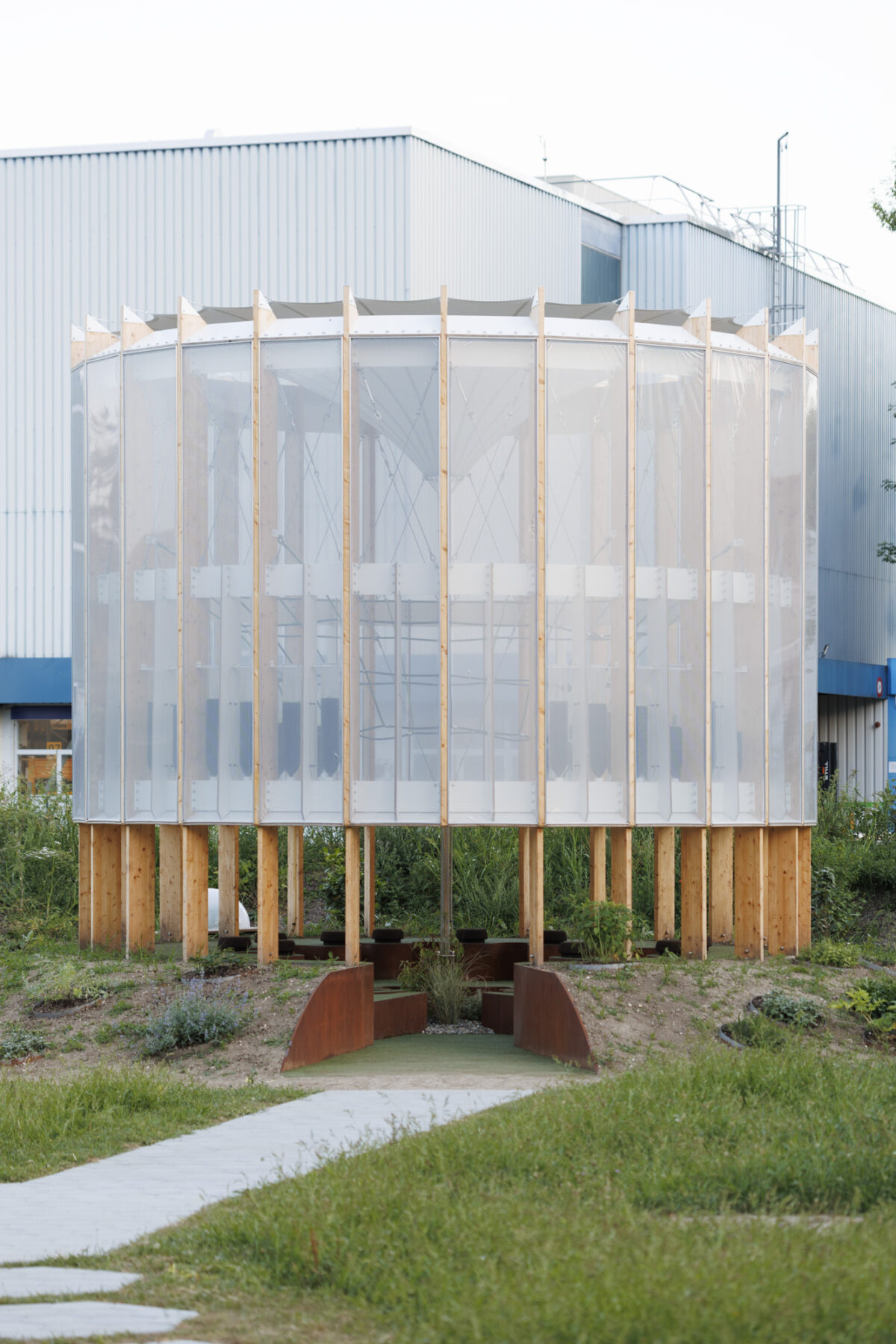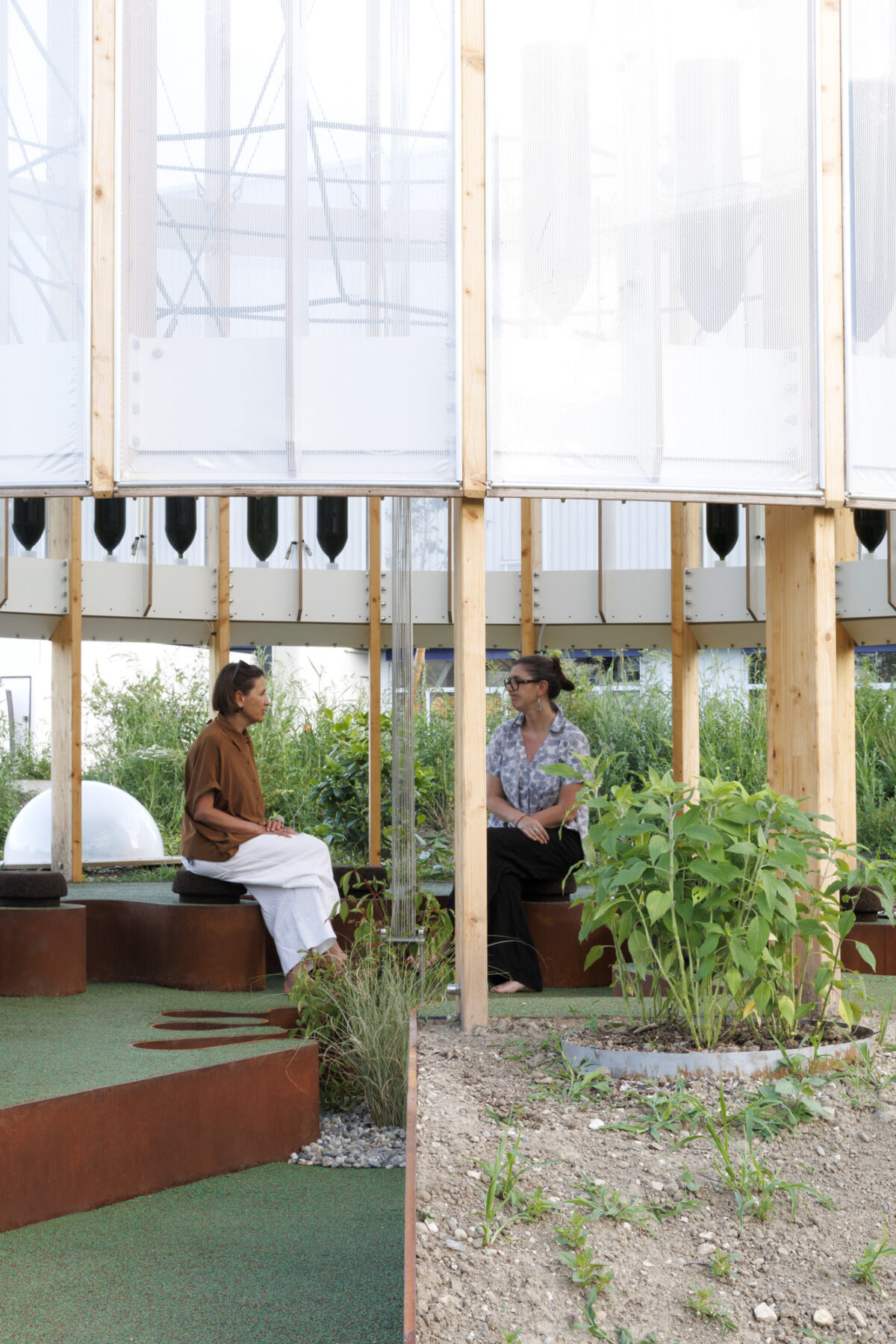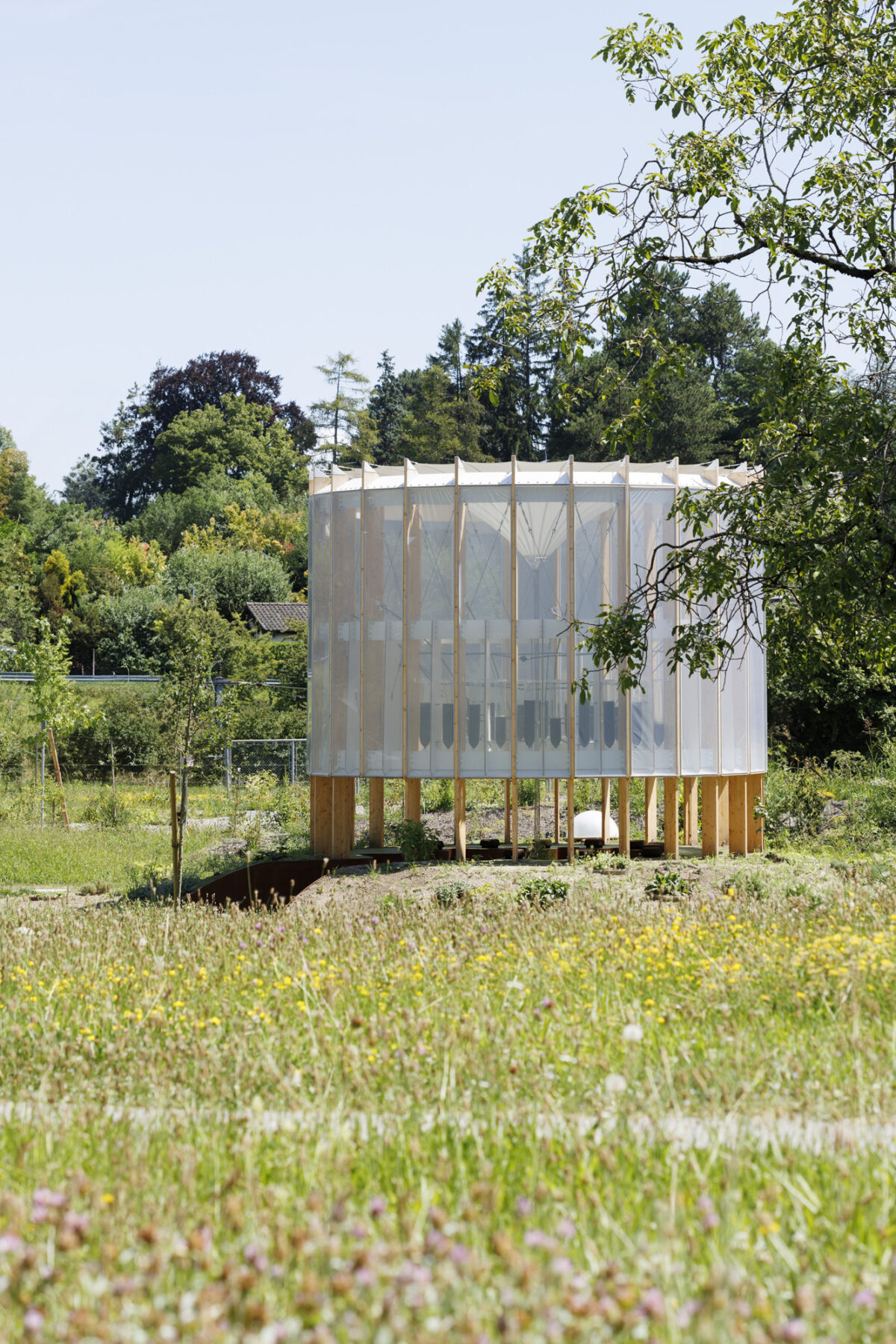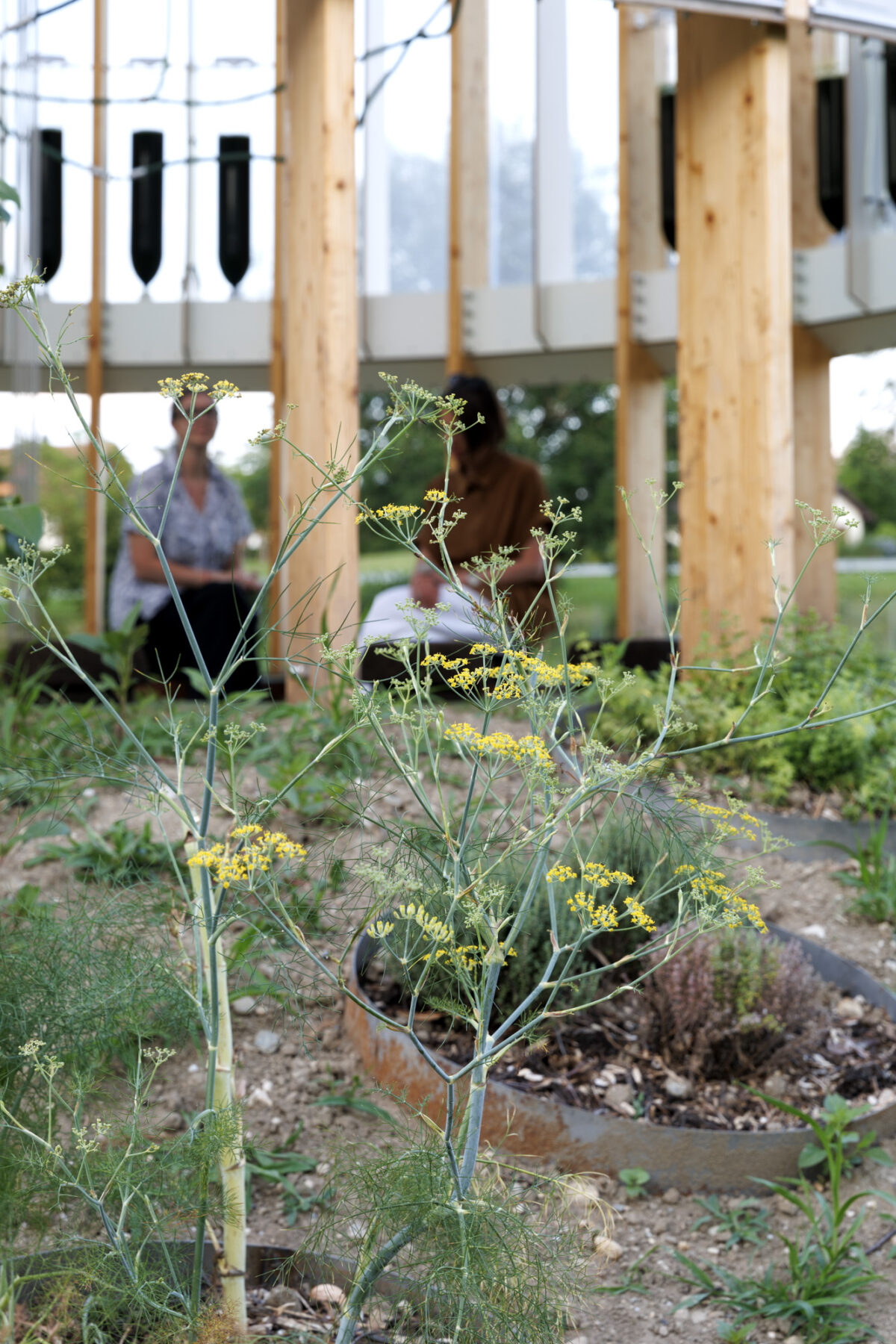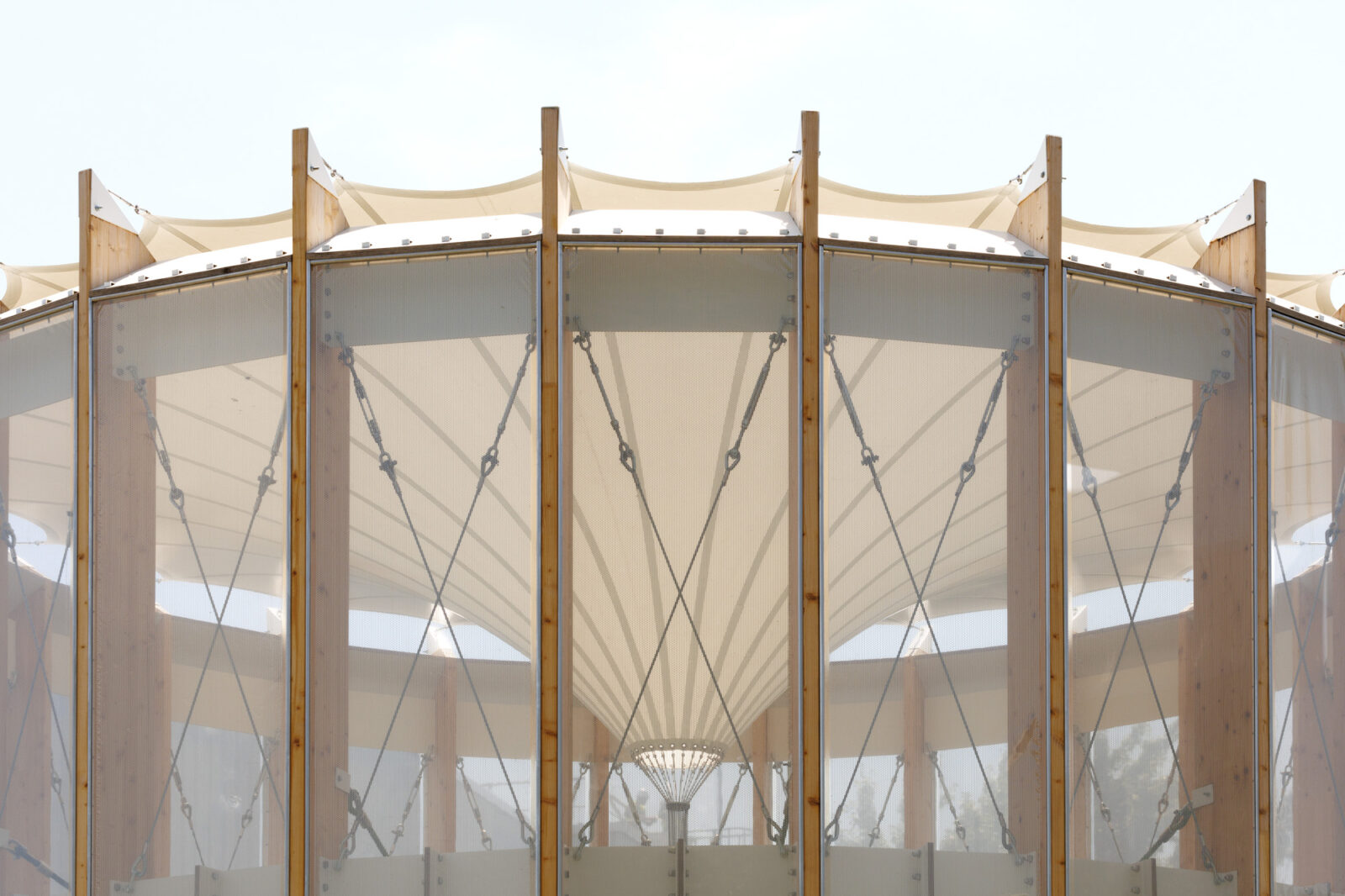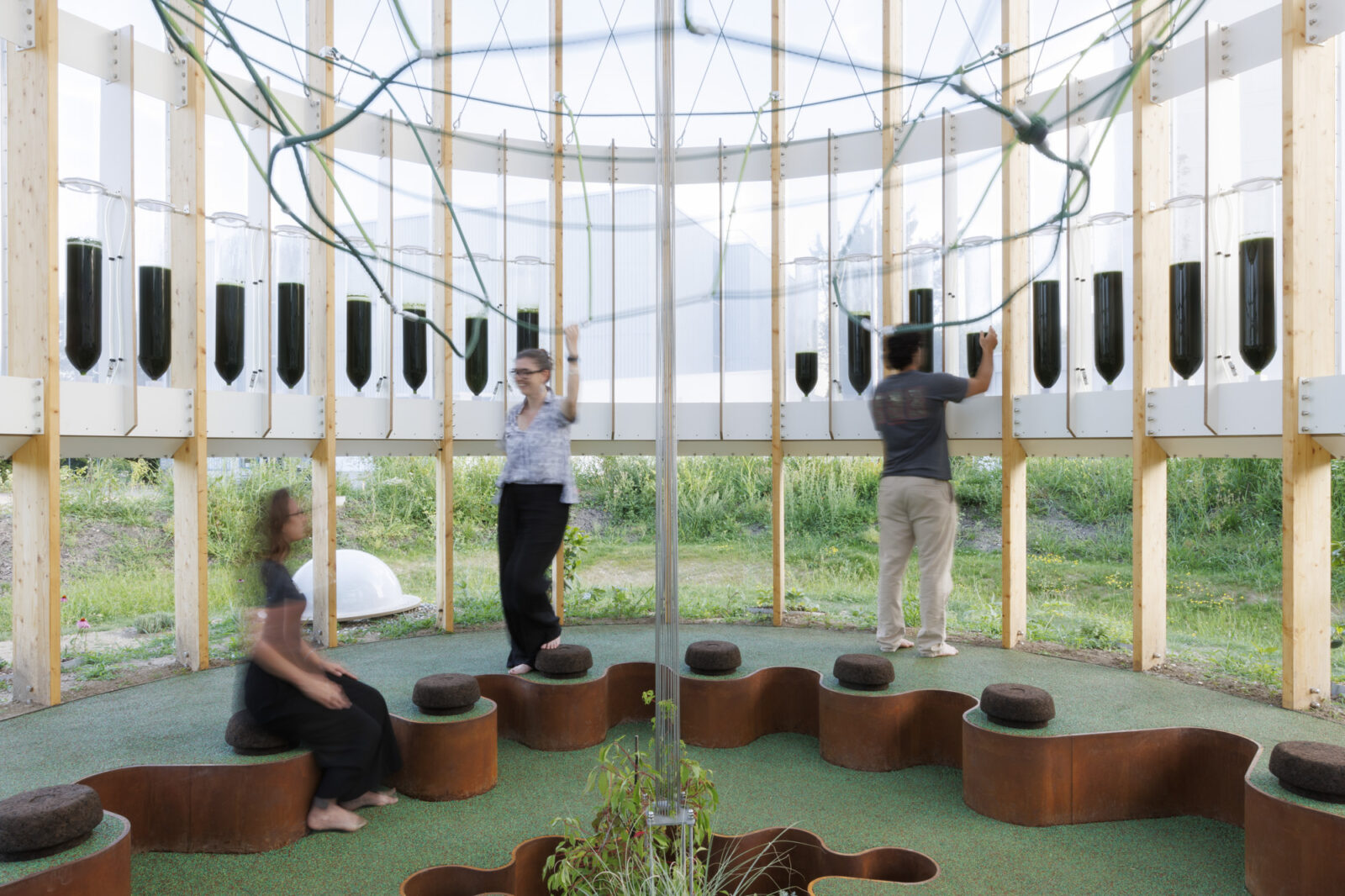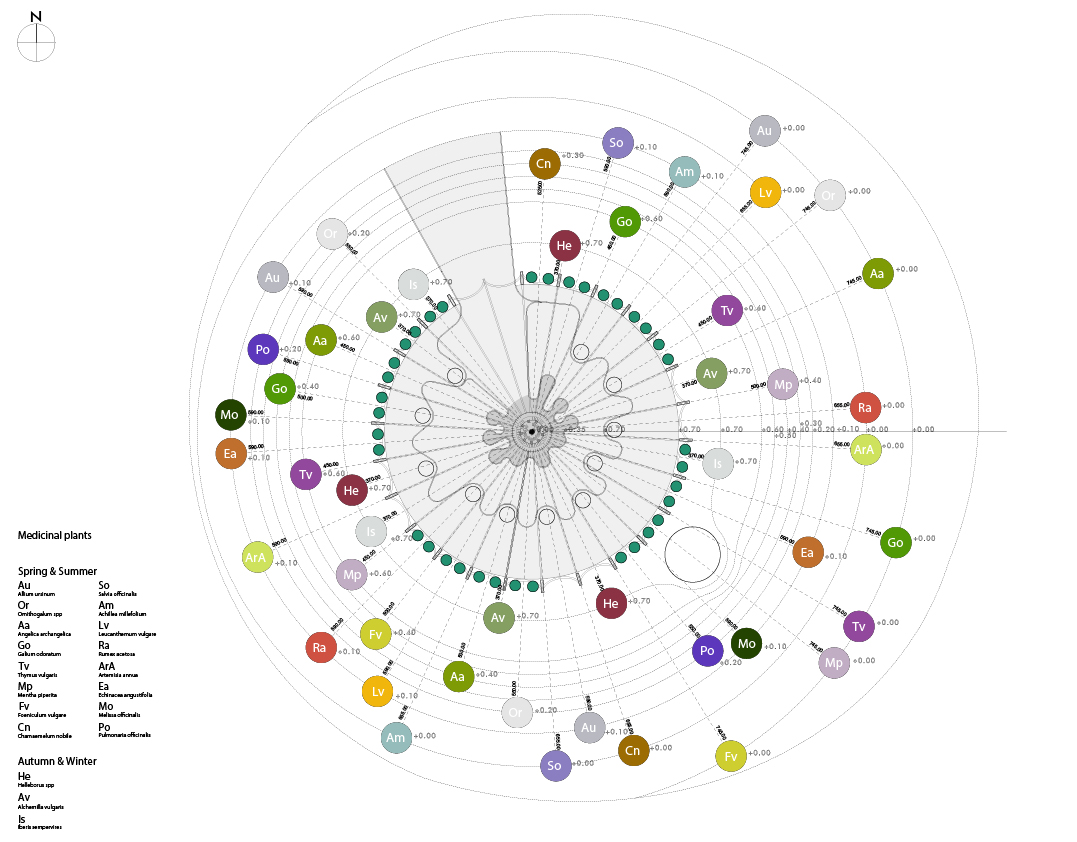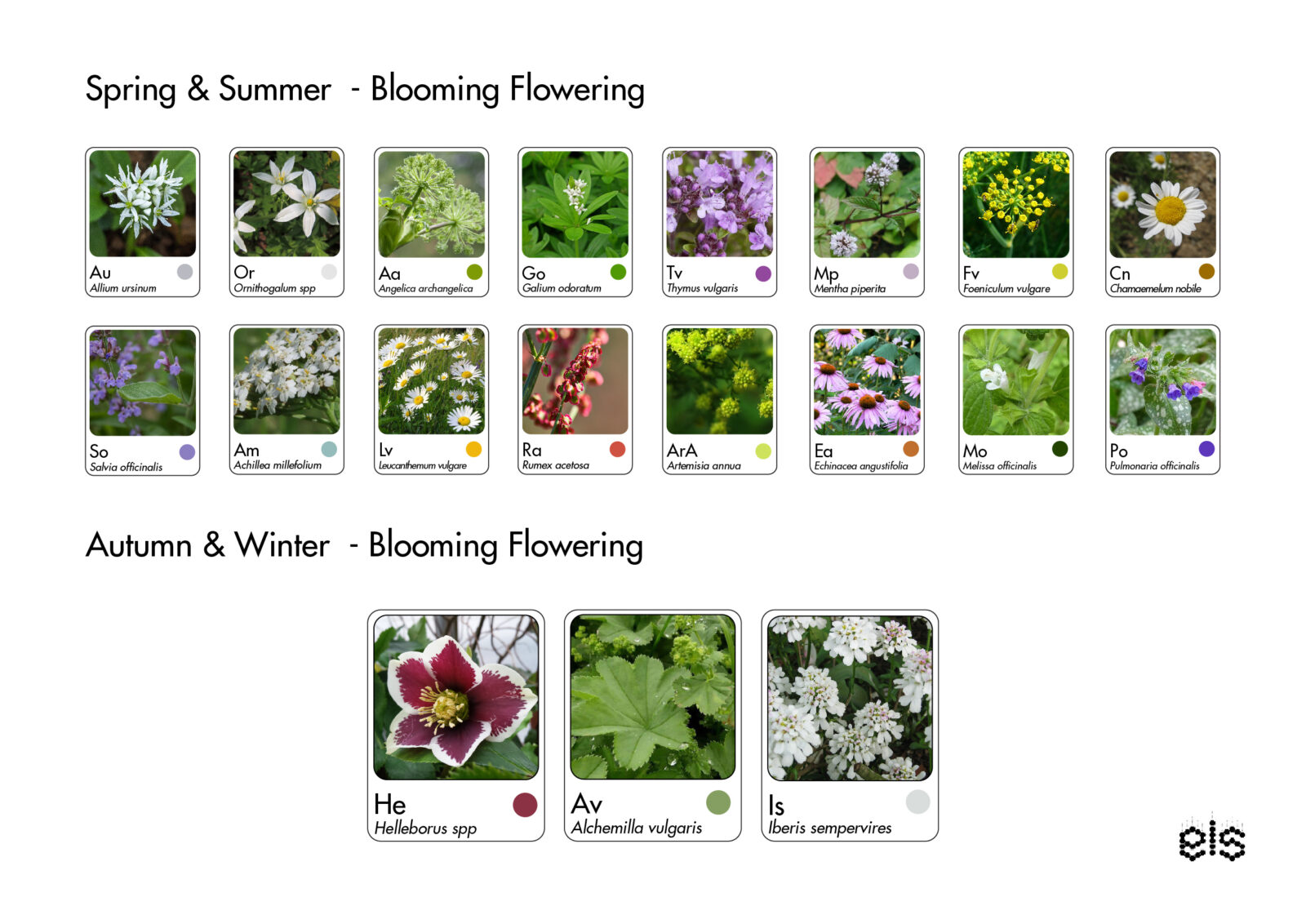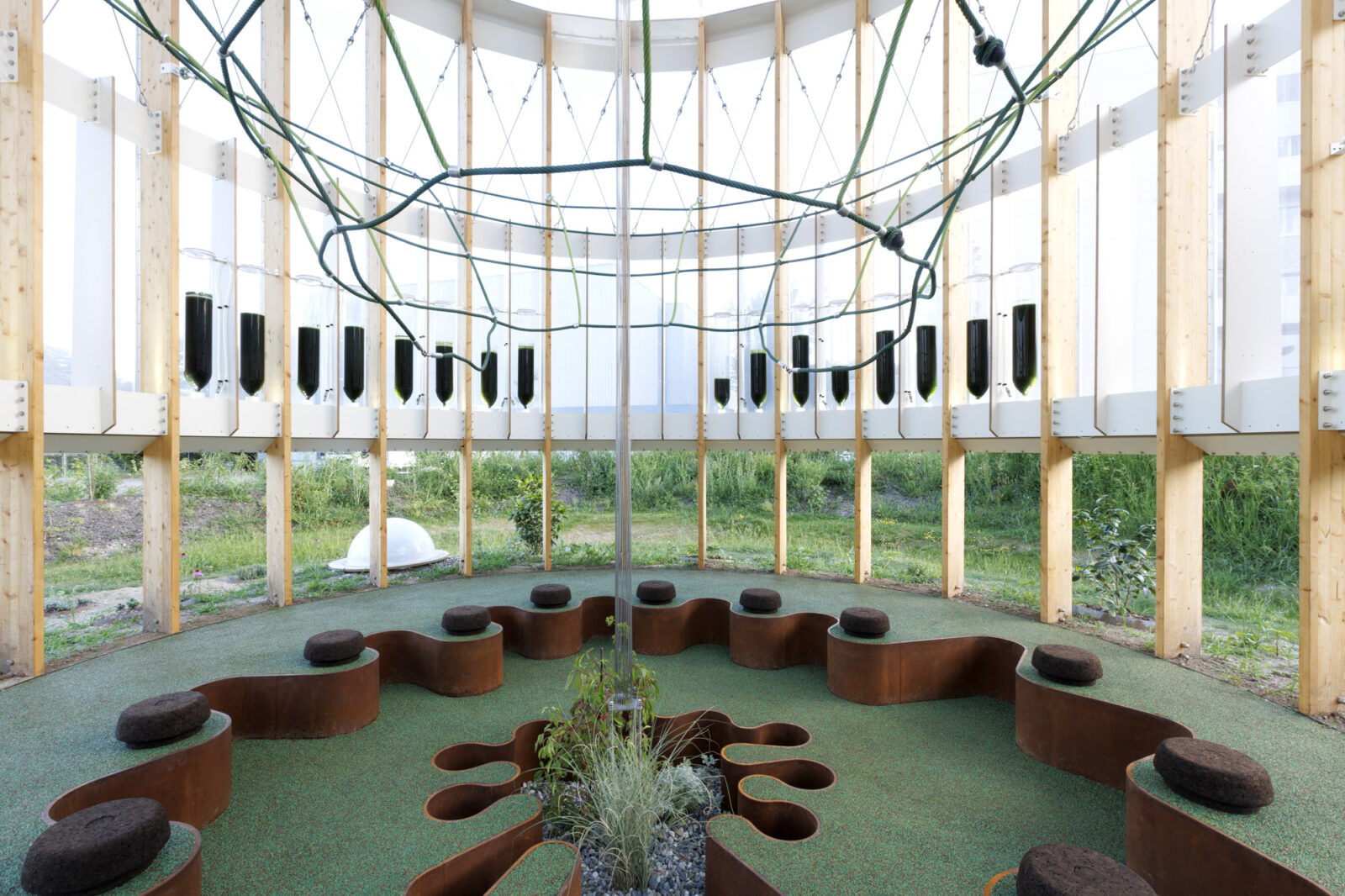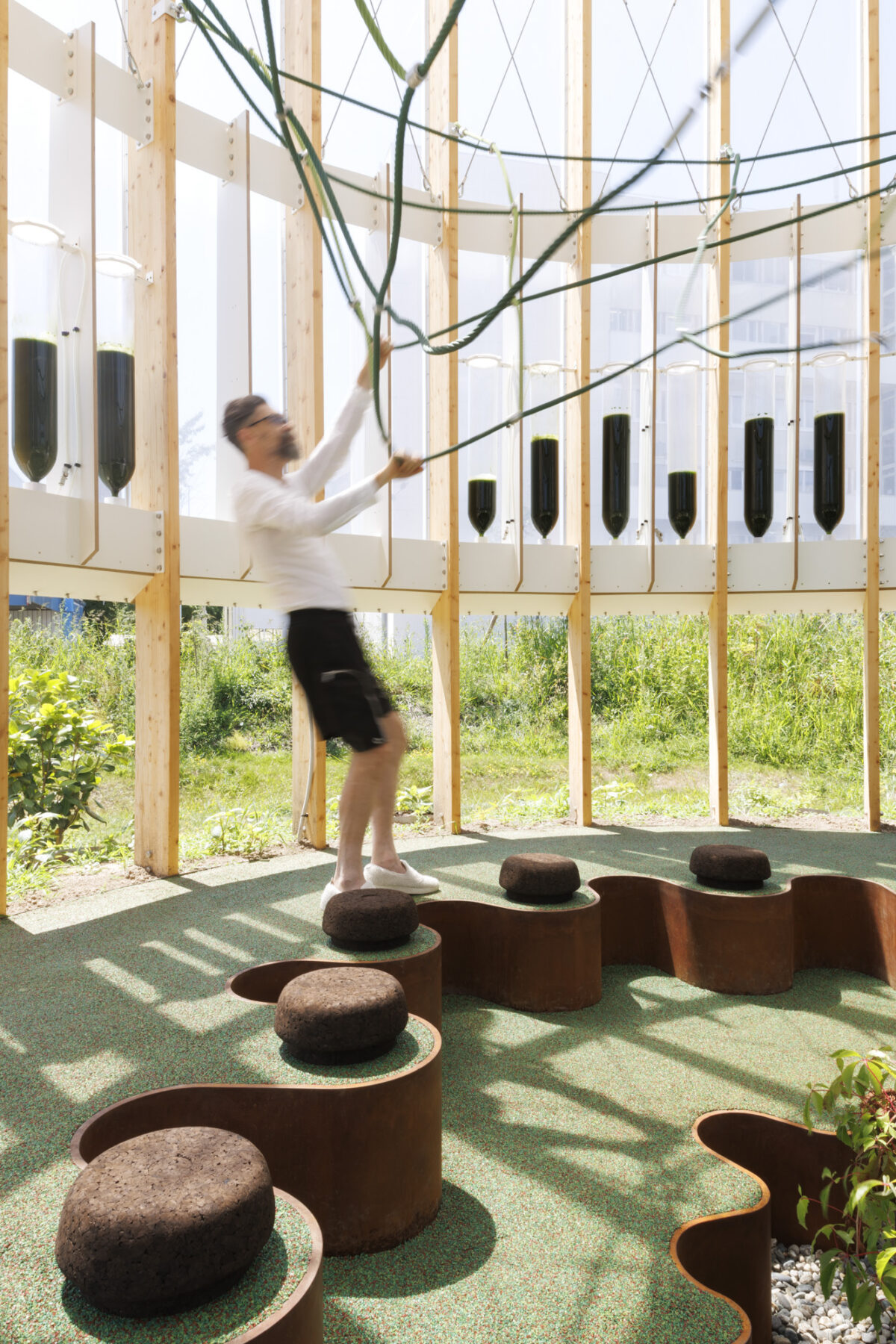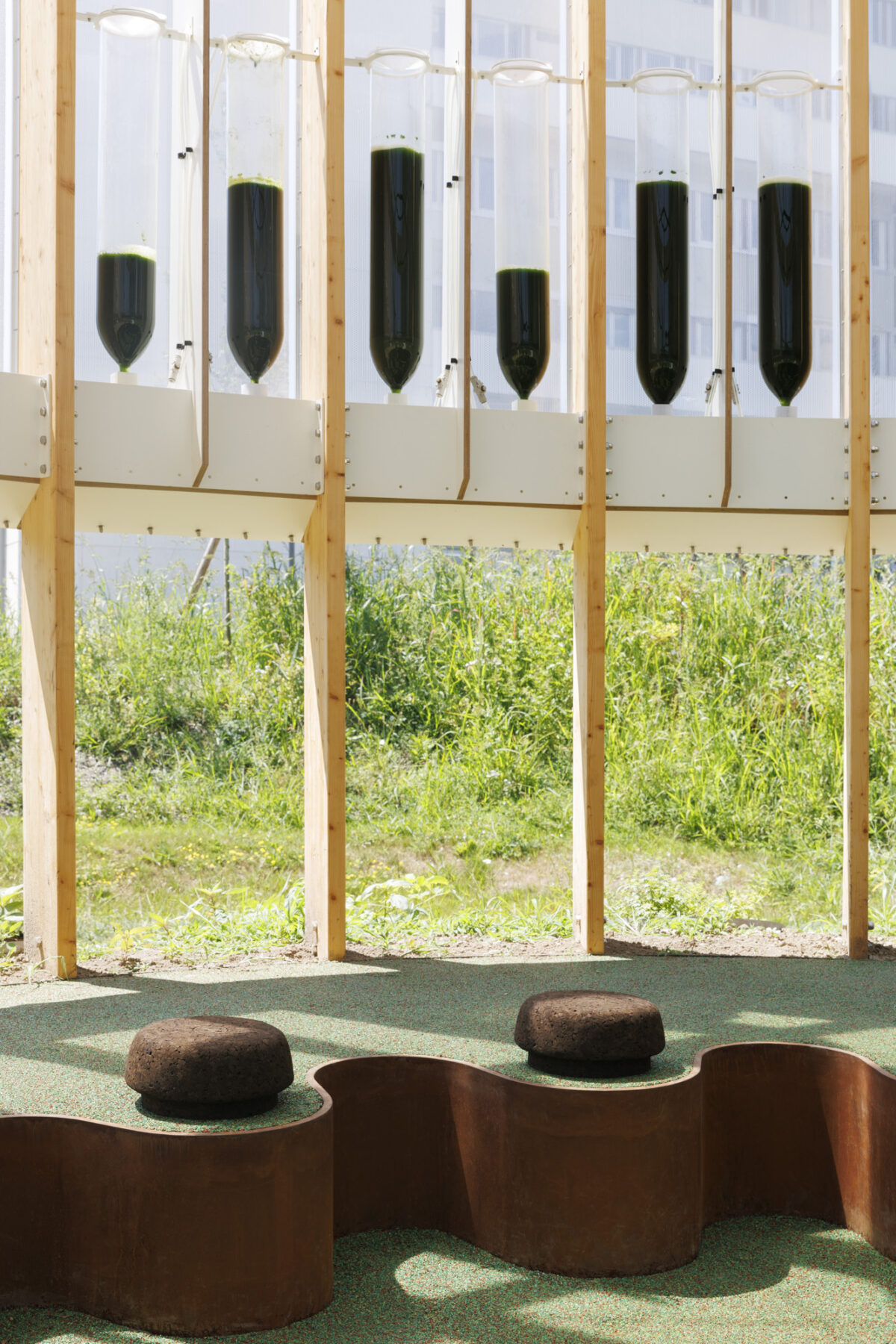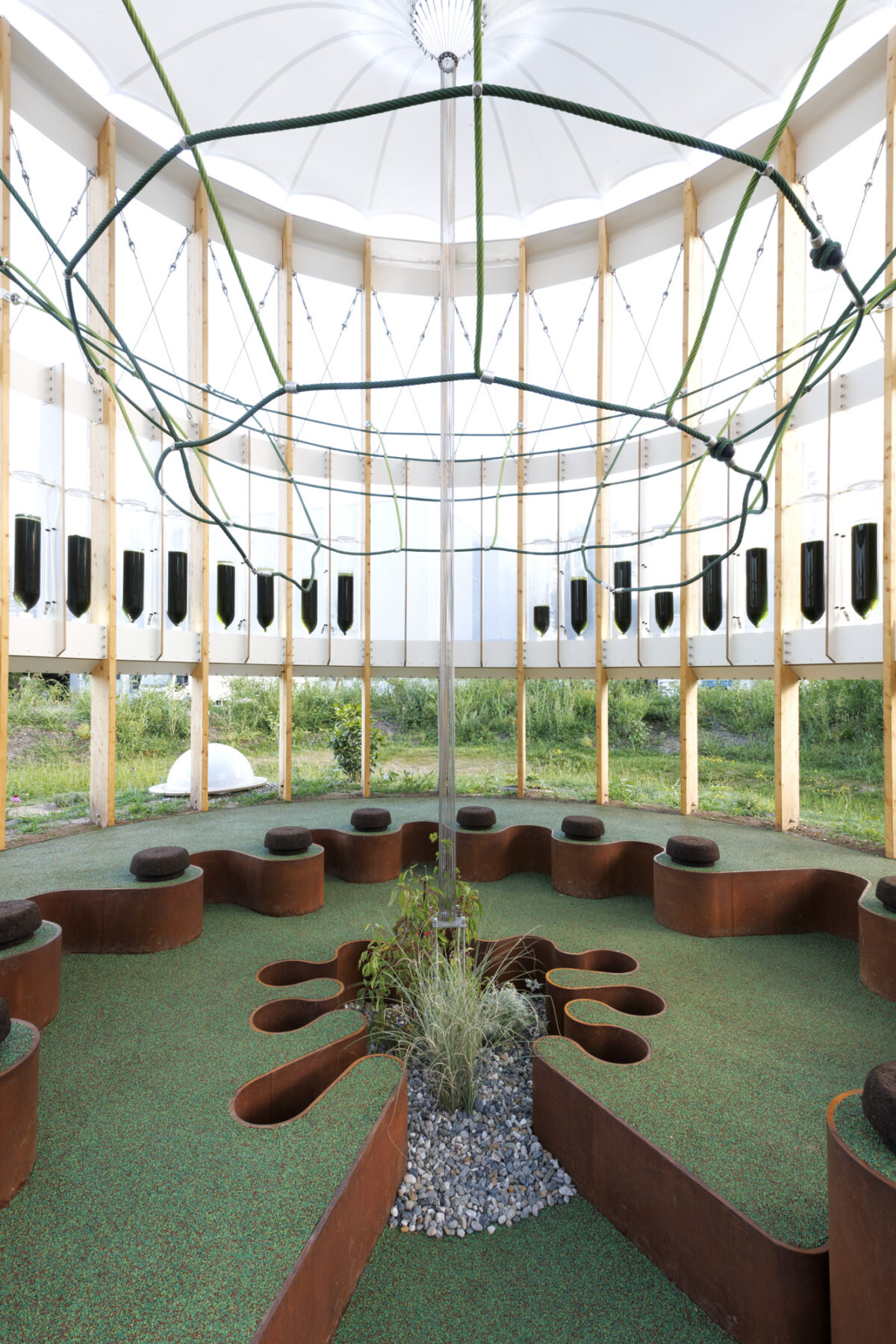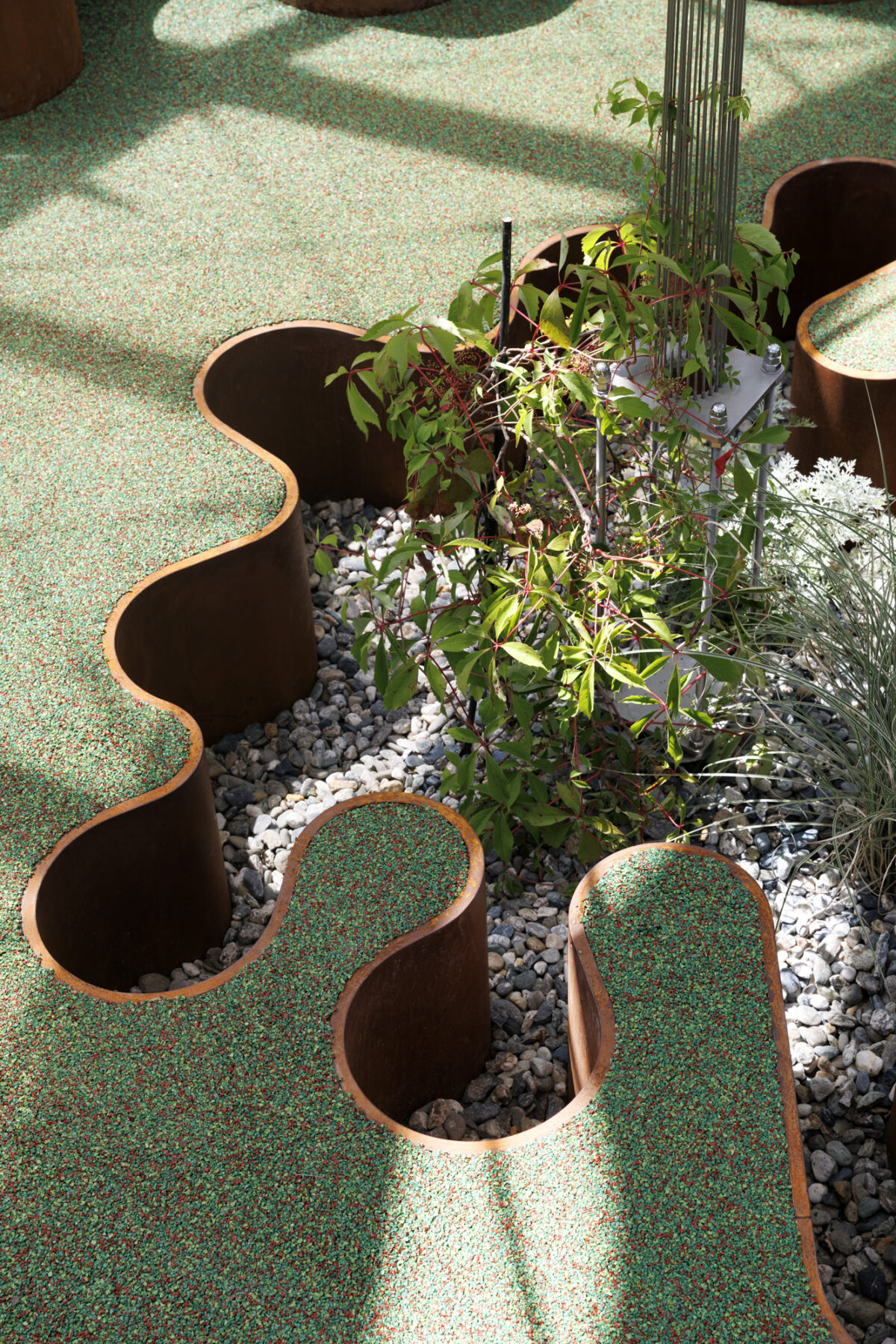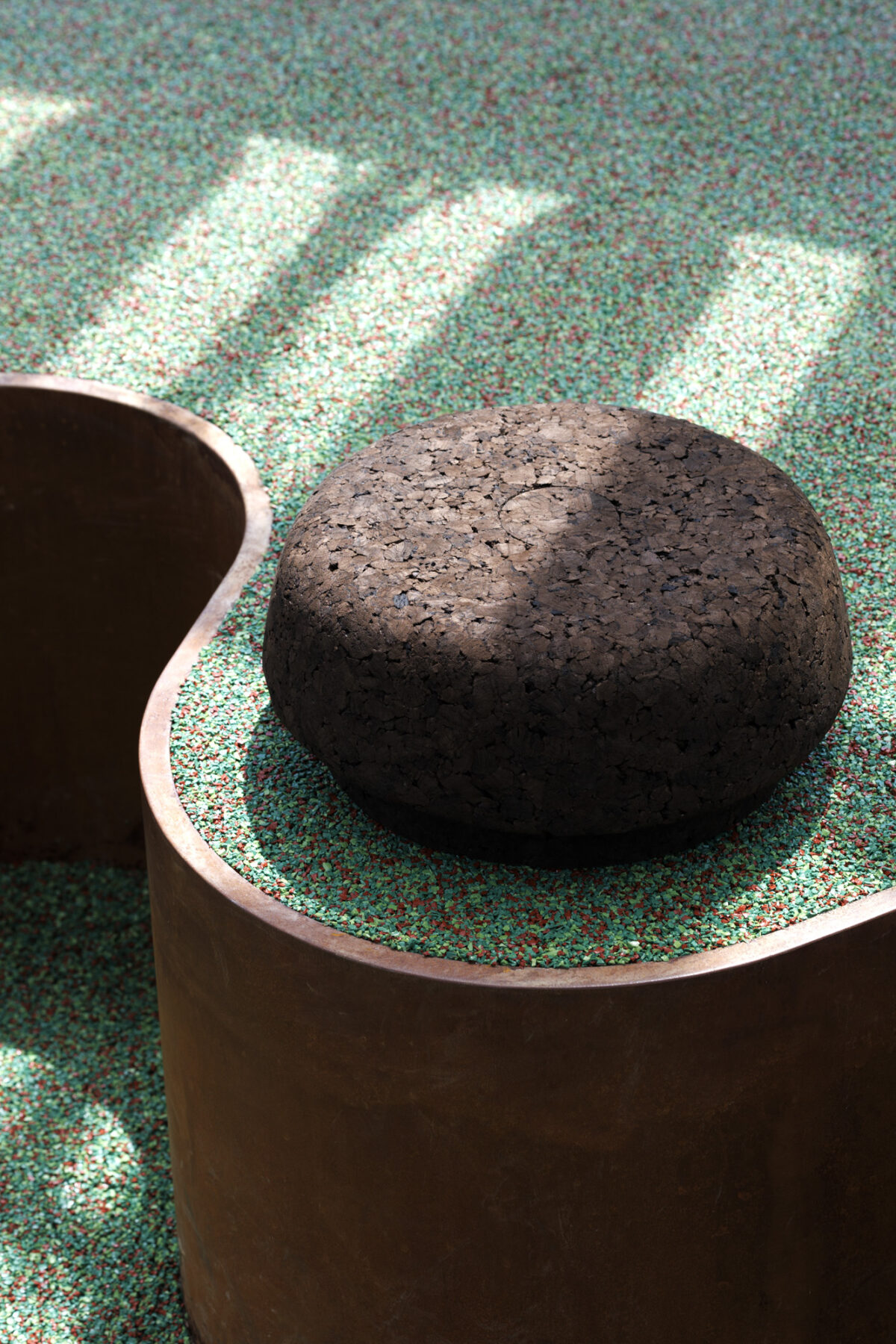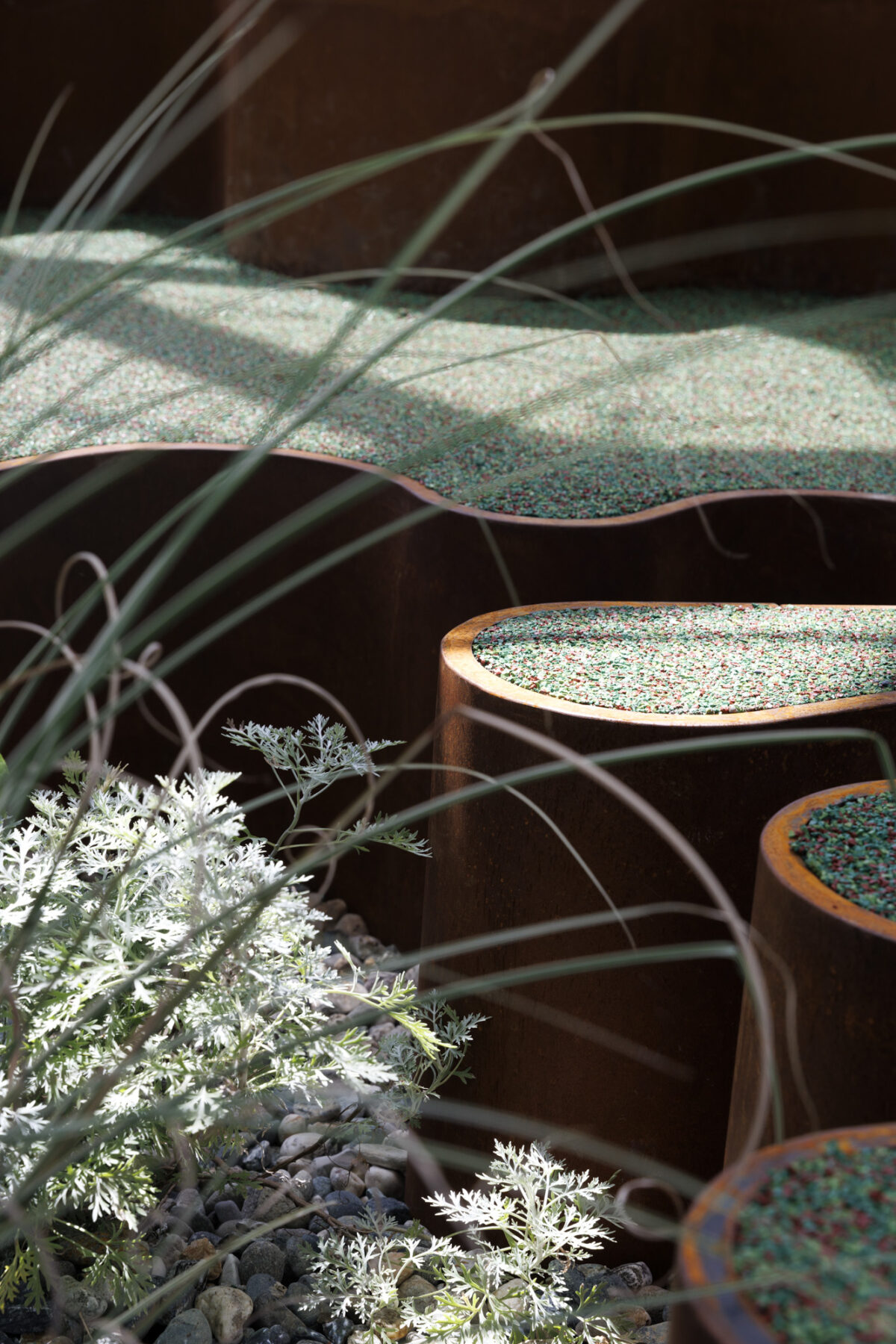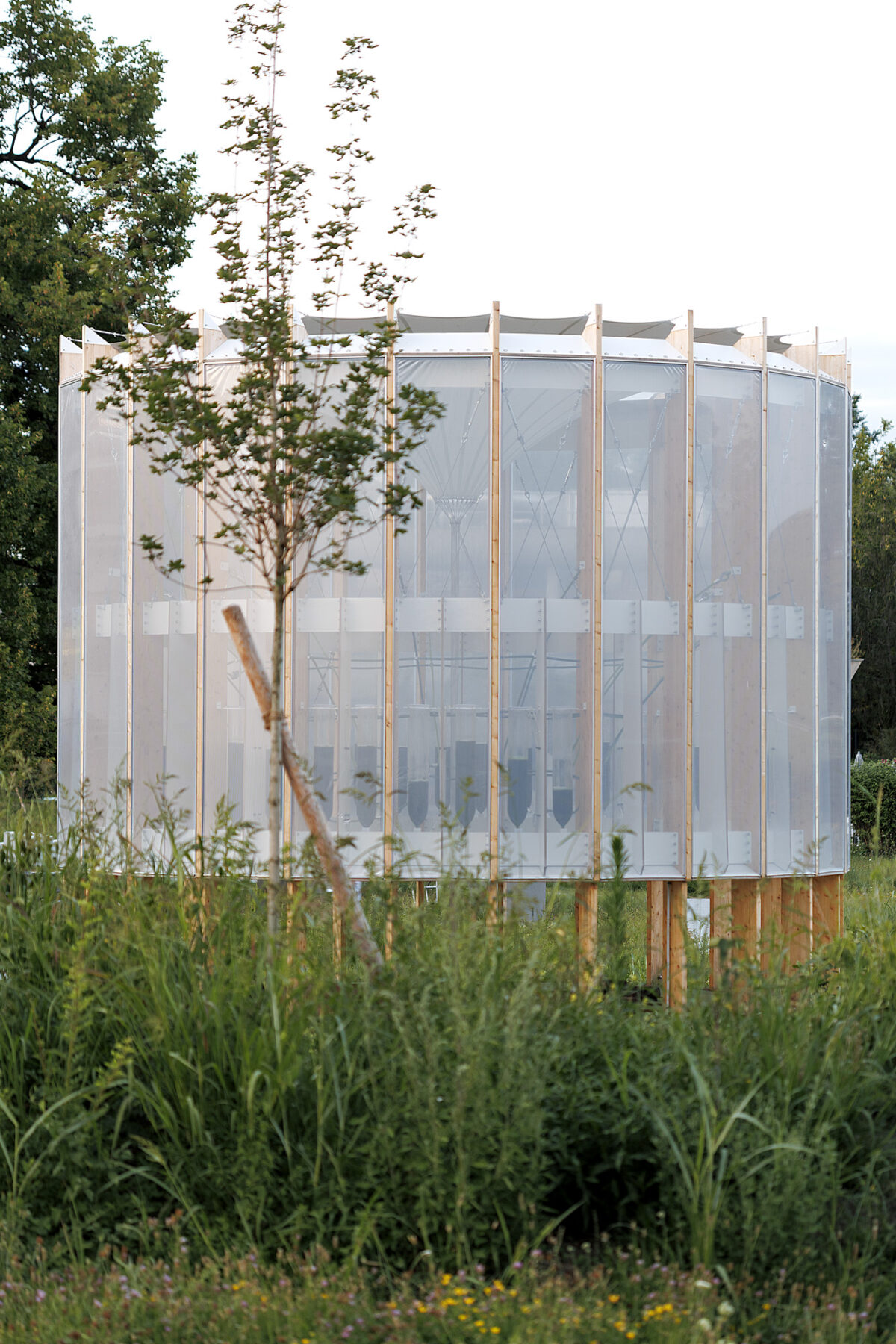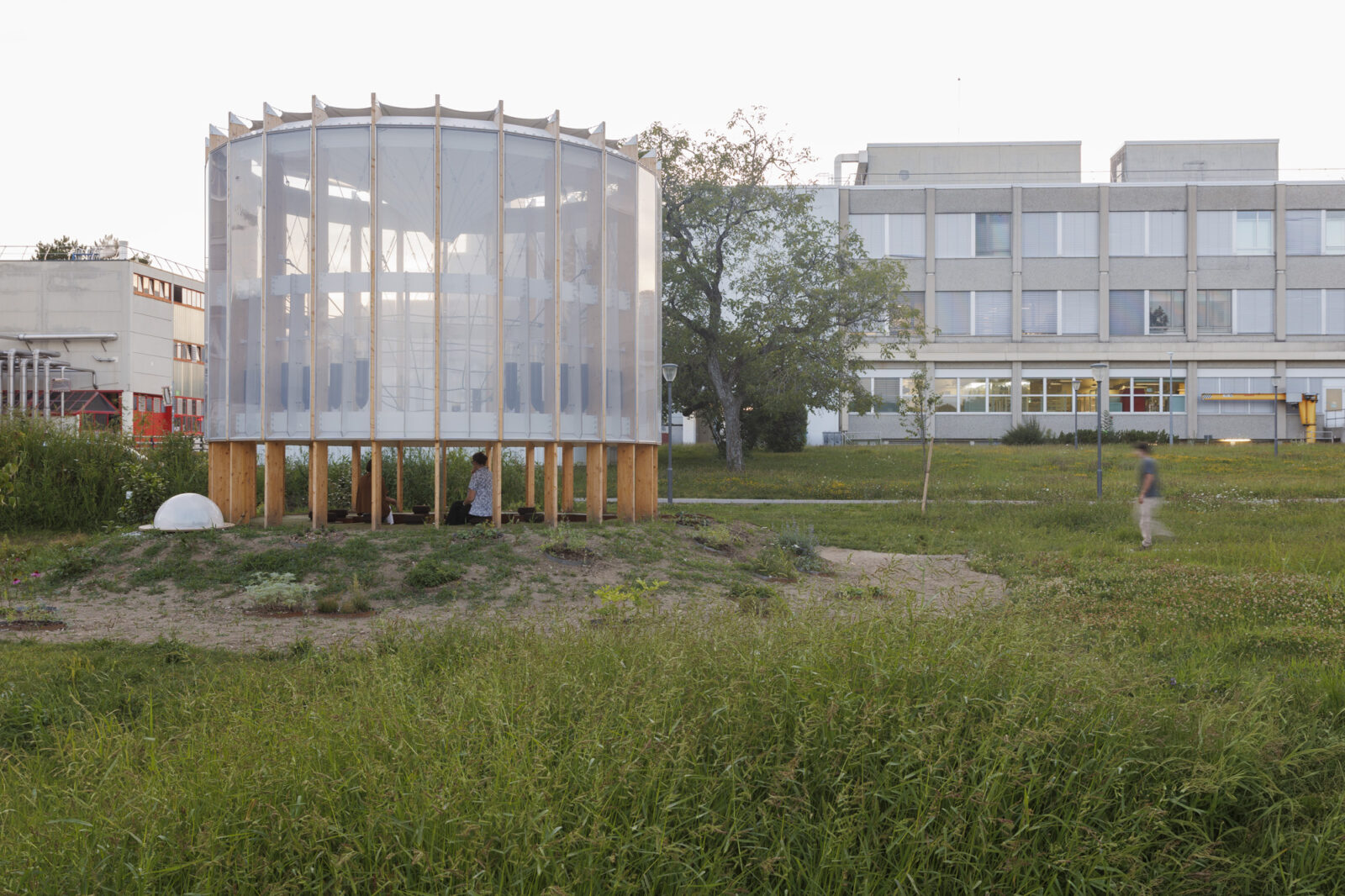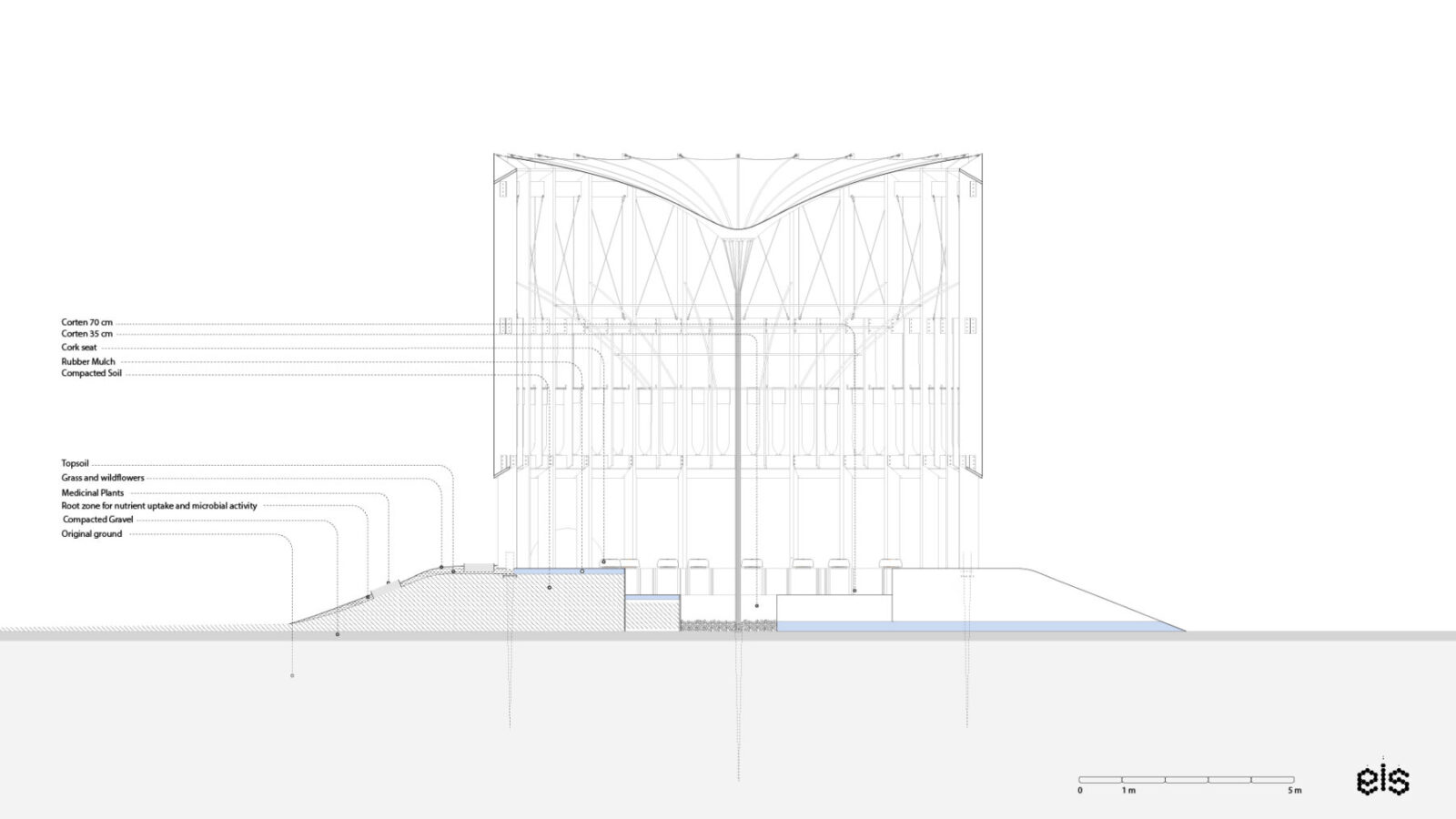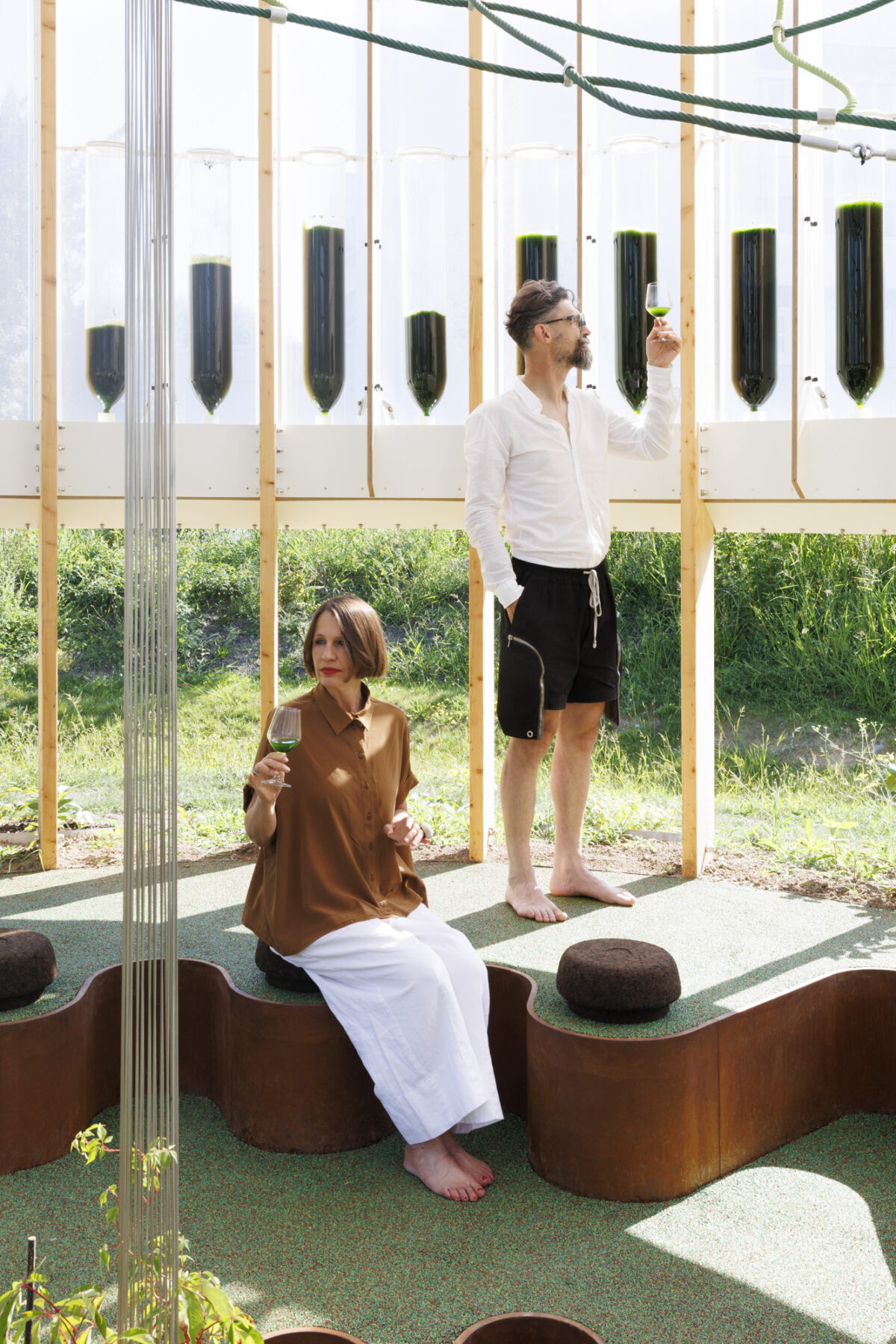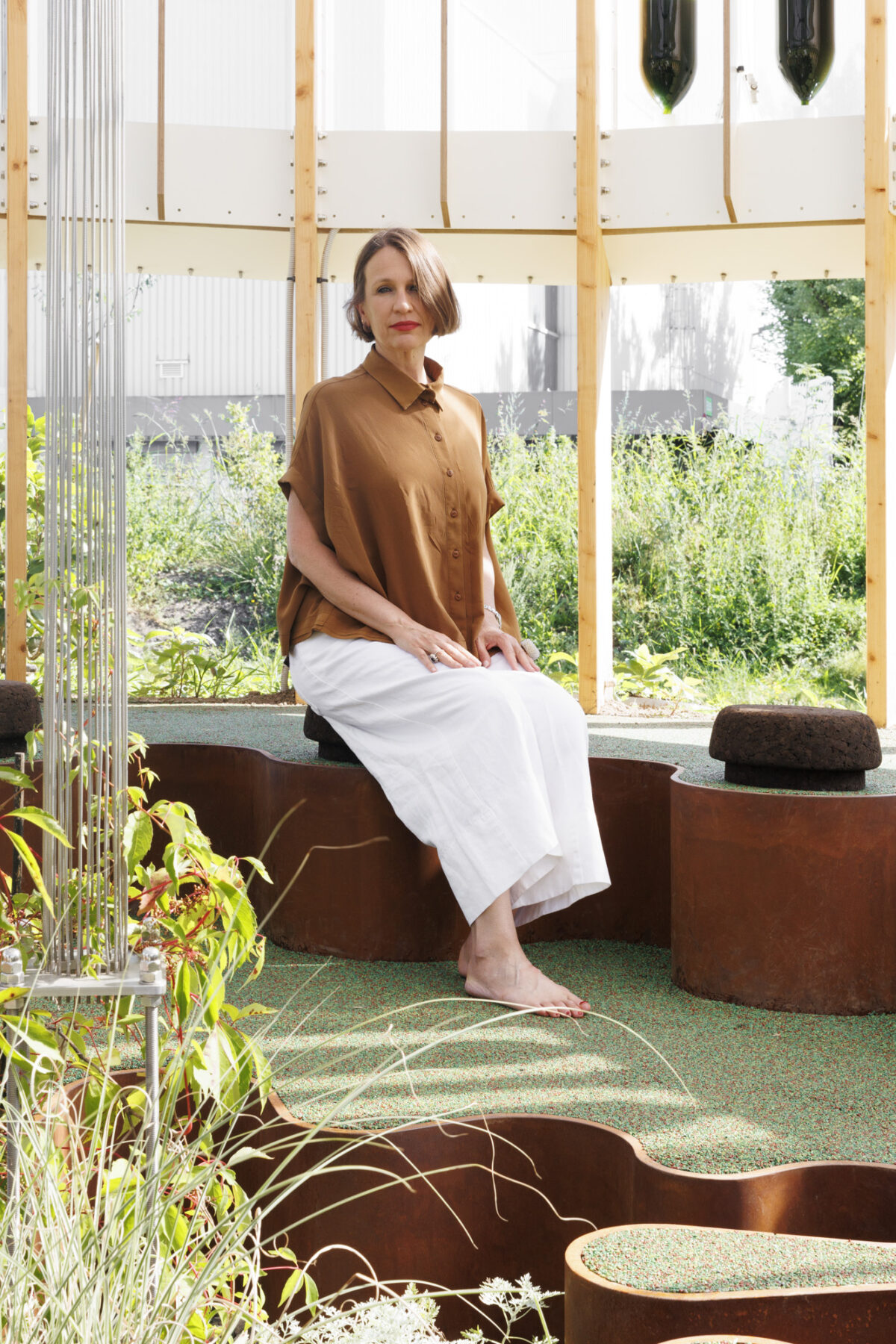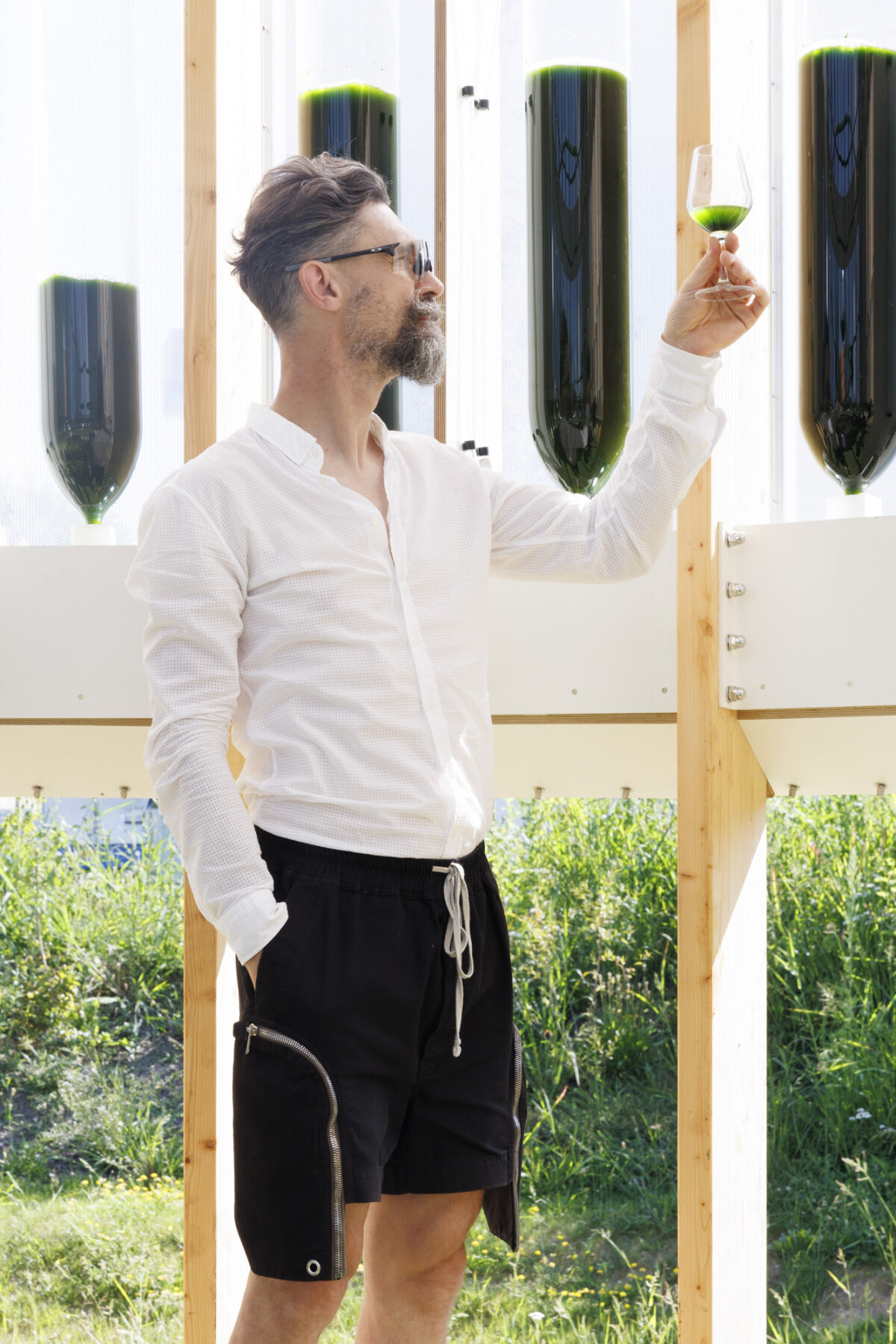Marking a new development in their long term research on urban wellbeing, ecoLogicStudio London- and Turin-based design innovation firm, completes the third iteration of their AirBubble design concept, a biotech garden for physical and mental healthcare.
The restorative space conceived for a Swiss consumer healthcare company establishes a new symbiosis between nature and humans.
The AirBubble restorative space is the world’s first biotechnological healthcare garden that combines air-purifying algae cultures with medicinal plants.
The project pioneers a new spatial concept balancing work, mental and physical health, relaxation, and interaction among employees from diverse departments. Moreover, it offers a multi-sensory experience enhanced by the oxygen bubbling and the scents of fresh herbs and flowers.
Located in Nyon (Switzerland), in the green area surrounding the factory grounds, the project is part of a wider vision called AirCampus. It includes the new AirBubble restorative space; the AirOffice – a symbiotic indoor workspace combining advanced gardening and air filtration; and the recently launched AIReactor, the biotechnological desktop air-purifier.
AirCampus is conceived as a pioneering architectural solution for health and wellbeing in the workplace, from indoor to outdoor spaces and from physical to mental health.
As a bio-design innovation project, the AirBubble restorative space is a replicable and scalable architectural system that can be installed into any work environment globally. The project brings to Nyon a new perspective on the relationship between workplace and landscape design by reinventing the model of the pre-industrial botanical garden and surpassing that of today’s healthcare industry.
“We researched the origins of pharmaceutical manufacturing by studying the medicinal garden of Padua in Italy, where medicinal essences and plants were grown as part of a community park. We then translated this concept into the biodigital era, where substances can once again be cultivated in the public realm.”
— says Marco Poletto, co-founder of ecoLogicStudio.
The AirBubble restorative space integrates the PhotoSynthetica™ technology which has been developed by ecoLogicStudio since 2018 within the namesake academic consortium. Starting in 2021, ecoLogicStudio began exploring how to integrate biotechnological systems into architecture, interiors, and landscape design.
The aim is to engage users in various phases of the air purification process, highlighting its benefits for human health, well-being in private and work spaces, and creating new green areas within factory production plants.
The AirBubble restorative space is composed of a 6 metres high cylindrical timber structure connected at 3 levels, wrapped in an ETFE membrane, sitting on the top of a landscaped mound. The middle section of the wooden structure hosts 36 large bioreactors in borosilicate glass which contain 350 litres of living green Chlorella algae cultures that can filter a flow of polluted air of 150 litres/minute. While the liquid medium washes particles, the algae actively eat the polluting molecules as well as carbon dioxide to then release fresh clean oxygen.
The filtering process is enhanced by the architectural morphology of the AirBubble restorative space: the inverted conical roof membrane further stimulates the air recirculation and natural ventilation.
The white bubbling sound of the algae gardening system masks the noise of the truck loading dock, creating a calming atmosphere ideal for relieving mind and body stress. Additionally, the harvested biomass can be incorporated into the canteen menu as algae drinks and vegetable protein bread or used as fertilizer for the wild meadow and the set of 47 medicinal plants concentrically arranged around the central seating area.
Visitors walk in onto a rubber surface composed of a mix of light and dark green as well as shades of brown particles leading to a broad two-level seating area. Two sinuous Corten metal sheets, chosen by the architects for its weathering properties, create a central petal-like sculpture – where the roof membrane converges into a small rainwater garden. A second Corten element highlights the perimeter where 11 cork seats are fixed into the rubberized surface. The seats are made from cork-chips that have been moistened to release a natural resin, forming several dark brown cork blocks that were then CNC-cut into softer morphologies.
Designed for the lightest touch on the ground, the wooden structure is anchored with 26 ground screws. By avoiding the use of concrete posts or pier blocks, this structural solution does not disrupt the landscape and it is fully reversible.
Furthermore, by implementing local plants that grow according to the season and by integrating rainwater collection, AirBubble restorative space does not use irrigation water thus preserving natural resources.
The AirBubble restorative space is encircled by a medicinal garden consisting of 47 planters. Closest to the main structure are four types of autumn and winter flowering plants: Alchemilla vulgaris, Iberis sempervirens, Camellia japonica and Helleborus. Moving away from the centre, 16 species that flower in spring and summer are distributed including common medicinal plants such as Salvia officinalis, Thymus vulgaris, Melissa officinalis, Mentha piperita, and plants with more specific properties such as Pulmonaria officinalis, traditionally used to treat disorders related to the respiratory system, or Nepeta cataria, with medicinal properties related to mental wellbeing and stress relief.
The project features a monitoring system that integrates urban air pollution sensors and measures the Air Quality Index for six core pollutants: fine particulate PM2.5 and PM10, ground level Ozone (O3), Nitrogen Dioxide (NO2), Sulphur Dioxide (SO2) and Carbon Monoxide (CO). AirBubble is capable of absorbing 97% of the nitrogen and 75% of the particulate matter in the air.
The AirBubble restorative space is part of a wider project focused on raising awareness of the impact of air pollution on human health, previous chapters of this endeavour are the AirBubble playground in Warsaw, the AirBubble inflatable air-purifying eco-machine installed at COP26, COP27 and Saudi Design Festival and the AirLab presented in London.
Facts & Credits
Project title AirBubble restorative space
Typology Landscape
Location Nyon, Switzerland
Architecture ecoLogicStudio (Claudia Pasquero, Marco Poletto)
Project Team Claudia Pasquero, Marco Poletto with Konstantina Bikou, Marco Matteraglia, Alessandra Poletto, Andrea Tiberi, Francesca Turi, Lucas Ursprung
Academic Partners Synthetic Landscape Lab IOUD Innsbruck University, Urban Morphogenesis Lab BPRO The Bartlett UCL
Structural Engineer YIP London
General Contractor ecoLogicStudio
Photography Pepe Fotografia
Text provided by the architects
ecoLogicStudio is an architecture and design innovation firm specialized in biotechnology for the built environment co-founded in London in 2005 by Claudia Pasquero and Marco Poletto. In 2018, ecoLogicStudio has launched the PhotoSynthetica venture with academic partners Synthetic Landscape Lab at the University of Innsbruck and the Urban Morphogenesis Lab at UCL London. The studio has built an international reputation for its innovative projects integrating systemic thinking, computational design, biotechnology and digital prototyping.
This “broadened” approach to design, ranging from the micro to the global scales, is embodied into an experimental practice where each project becomes a laboratory, a real test bed of future models of inhabitation of the Urbansphere. ecoLogicStudio is currently developing scalable nature based solutions to the many challenges facing contemporary cities in their quest to carbon neutrality and to offset the effects of climate change. Completed projects include several installations and experimental pavilions, a public library and a private house, a large eco-roof as well as several urban blue-green planning proposals.
CLAUDIA PASQUERO
Claudia Pasquero is an architect, curator, author and educator; her work and research operates at the intersection of biology, computation and design. She is co-founder of ecoLogicStudio in London, Professor of Landscape Architecture, founder of the Synthetic Landscape Lab and Head of Institute for IOUD at Innsbruck University; Associated Professor and Director of the Urban Morphogenesis Lab at the Bartlett UCL in London. Claudia has been Head Curator of the Tallinn Architecture Biennale 2017, which she titled BioTallinn, and she has been nominated in the WIRED Smart List in the same year. She is co-author of “The World Dubai Marine Life Incubator: Eco Machines V.3.0”; “Systemic Architecture – Operating manual for the self-organizing city” published by Routledge in 2012, and of “Biodesign in the age of artificial intelligence: Deep Green” published by Routledge in 2023. Her work has been exhibited internationally: Hyundai Motorstudio Busan and Seoul, Centre Pompidou in Paris, Design Museum in London, Venice Architecture Biennale, Mori Museum in Tokyo, ZKM Karlsruhe, Saudi Art Biennale in Riyadh, COP26 in Glasgow among others. ecoLogicStudio has successfully completed a series of photosynthetic architectures, such as, the Urban Algae Folly Milano 2015, the BioTechHut Astana 2017, PhotoSynthEtica Dublin 2019, PhotoSynthetica Helsinki 2020, AirBubble Playground Warsaw 2021, upon others.
MARCO POLETTO
Marco Poletto is an architect, educator and innovator based in London. He is co-founder and Director of the architectural practice ecoLogicStudio and the design innovation venture PhotoSynthetica, focused on developing architectural solutions to fight Climate Change. In the past 10 years ecoLogicStudio has designed and built several living installations and architectures, demonstrating how microorganisms such as algae can become part of the biocity of the future. Marco holds a PhD Degree from RMIT University, Melbourne. His thesis on the “Urbansphere” argues that the increased spatial integration of non-human systems within architecture is crucial to evolve higher forms of urban ecological intelligence. He is co-author of “The World Dubai Marine Life Incubator: Eco Machines V.3.0”; “Systemic Architecture – Operating manual for the self-organizing city” published by Routledge in 2012, and of “Bio-design in the age of artificial intelligence: Deep Green” published by Routledge in 2023. Marco has been Unit Master at the Architectural Association in London, Visiting Critic at Cornell University and Research Cluster leader at The Bartlett, UCL. He currently Lectures at the University of Innsbruck and the IAAC in Barcelona. Marco’s work has been exhibited internationally, more recently in Korea (Hyundai Motorstudio Busan and Seoul, 2023) in Paris (Centre Pompidou, 2019 and 2022), Tokyo (Mori Gallery, 2019), Vienna (MAK, 2019), Karlsruhe (ZKM, 2019) and Astana (EXPO 2017).
READ ALSO: "Mediterráneo" in Valencia | by Manuel Bouzas
